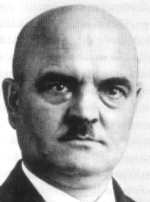 |
| Wirth * |
Christian Wirth was born on
24 November 1885 in
Oberbalzheim, (former German state Württemberg). He was a joiner, and
since
1910 policeman. He served on the Western front
during WW1. After the war, he spent several years as a builder, then he became a police officer in
Stuttgart (murder squad) in the
1930’s.
He was notorious for the manner in which he conducted his investigations and his dedication to duty.
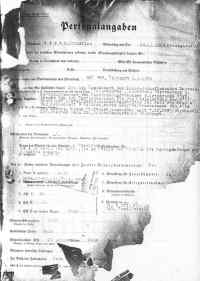 |
| Wirth's personal SS Sheet * |
Wirth joined the NSDAP in
1931, the SA (
1933), SD
(
1937) and SS (
1939). Already
in
1922 he became member of the NSDAP the first time.
By
1939, he had risen in rank to
Kriminalkommissar in the
Stuttgart criminal police, a department of the
Gestapo. In
October 1939 he was sent as a
Kriminaloberkommissar and
SS-Obersturmführer to the
Grafeneck psychiatric clinic for service in the
Euthanasia Programme, meanwhile being a member of the SS
(SS number 345,464).
At
Grafeneck he became chief of the office and met
Josef Oberhauser, a crematorium attendant, who was to become his adjutant in
the death camps in Poland.
Kurt Franz, who later became camp commander of
Treblinka, was chief of the kitchen.
At the end of the year
1939 Wirth was ordered to
Brandenburg an der Havel, where
a part of the former
Zuchthaus (prison) has been converted into a euthanasia establishment. There he was in
charge of administration, and organized its office. He led the first gassing experiment: A small group of
insane criminals from the prison was gassed with CO gas.
Philipp Bouhler and
Viktor Brack, both from the
Führer’s Chancellery, observed the
gassing.
Bouhler then suggested to disguise the T4 gas chambers as shower-rooms.
A short time later, Wirth returned to
Grafeneck and was promoted in
mid-1940 to become inspector of all euthanasia establishments in Germany and Austria.
Later he became chief of the "registry office" at the
Hadamar euthanasia centre, and chief of the
Hartheim euthanasia centre.
Franz Stangl, who was to be commandant of
Sobibor and
Treblinka, first met
Wirth at
Hartheim, and recalled in an interview in
1971 with
Gitta Sereny, that
"
Wirth was a gross
and florid man and my heart sank when I met him. He stayed at
Hartheim for several days that time, and came back often.
Whenever he was there, he addressed us daily at lunch, with an awful crude language."
In
September 1941 Brack and
Bouhler sent
Wirth to
Lublin to set up a new euthanasia establishment, the first of its kind
outside the
Reich, but the project was abandoned. Wirth’s activities during this period, prior to his
appearance at
Belzec, are obscure. Shortly before
Christmas 1941 Wirth arrived in
Belzec, a village in the far south-eastern corner of the
Generalgouvernement. He took with him a small group of T4 men, among them
Erich Fuchs, a driver and mechanic.
Fuchs
stated:
"
One day in the winter of 1941/42, Wirth put together a
transport. I was selected with about 8-10 men, and transferred to
Belzec in three lorries. In my group were
Borowski, Niemann, Graetschus, and Barbel."
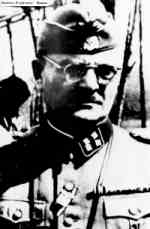 |
| Wirth * |
Wirth was the first commandant of
Belzec; he told the SS-men that "in
Belzec
all the Jews were to be killed". A number of the SS staff nicknamed him "
Christian der Grausame" (the savage),
and according to SS man
Ernst Zierke, "Wirth went over bodies". At
Belzec Wirth developed the camp hierarchy, and the very
brutal manner in which the mass gassings were to be carried out.
Josef Oberhauser
said of him:
"
His dominant features were an iron hardness, unconditional obedience,
belief in the Führer, absolute heartlessness and ruthlessness."
Wirth personally selected from the initial transports 80-100 young and fit
males as the nucleus of the camp work force, to be led by a Jewish camp leader, assisted by two
Oberkapos.
They in turn selected other
Kapos to oversee the individual work-brigades.
Wirth provided the Jewish camp leaders with detailed instructions about the
duties of the work brigades and their role in the destruction process that he had devised. In the early days of
Belzec, Wirth addressed the Jews upon arrival at the camp, informing them that
they were to have a bath before being resettled. The Jews often cheered him after his speech.
SS-Lieutenant
Kurt Gerstein, who was in charge of the Technical Disinfection
Department of the
Waffen-SS, visited
Belzec in the late
summer of 1942, having been
ordered by
SS-Sturmbannführer Günther of the
RSHA to test
methods of disinfecting clothing, and to change the current method of gassing (prussic acid or exhaust fumes).
In
May 1945,
Gerstein described the extermination process:
"
A transport of Jews from
Lwow (Lemberg) arrived at Belzec,
and was sent to the gas chambers. Wirth, standing on the platform, whipped a Jewess of about 40 in the face and chased
her into the gas chamber. SS-Unterscharführer Hackenholt
tried to set the diesel (?) engine moving, but it did not start. Captain Wirth came along. He was furious and dealt
the Ukrainian who was helping Hackenholt 11 or 12 lashes in the face with his
whip. The diesel (?) engine started up, after 2 hours 49 minutes."
Wirth asked
Gerstein not to recommend any
other type of gas chamber in
Berlin.
Gerstein obliged by saying that the
prussic acid he had brought with him had been damaged.
Gerstein then buried
the
Zyklon B somewhere at
Belzec.
The
Belzec survivor
Rudolf Reder also encountered
Wirth, and described him:
"
He was tall, broad shouldered man in his middle 40’s with a vulgar face. He
was a born criminal, 'The extreme beast'."
The Ukrainian
Trawniki-Männer referred to Wirth as "
Stuka",
the German dive-bomber that made a screaming noise as it went into a dive. Wirth
attempted to instil some discipline into the
Belzec garrison, both German and Ukrainian, by ordering route marches
outside the camp. Wirth himself marched at the head of the column, closely
followed by
Niemann, Oberhauser, Schwarz, and Franz.
He was a rabid anti-semite, and his depraved behaviour plumbed the depths.
Chaim Hirszmann witnessed how, when a transport of children and infants
arrived at
Belzec, they were buried alive in a large pit. At the height of
Aktion Reinhard,
Wirth’s brutality became even more pronounced. SS-man
Werner Dubois, who served at
Belzec and
Sobibor, stated:
"
Wirth was more than brutal. In my opinion, his brutality was grounded more in his
human nature, than as an emanation of his political mentality. He bellowed, screamed and threatened us, and hit
members of the German camp garrison in the face. Other than Oberhauser, there
was no-one in Belzec who was not afraid of Wirth."
In
June 1942 Oberhauser returned to
Belzec to find the camp practically deserted;
there were only about 20 Ukrainian guards under the command of
SS-Scharführer
Feix. Wirth had disappeared.
Oberhauser stated:
"
I discovered that Wirth had gone to Berlin, via
Lemberg and Krakau, without first
reporting to
Odilo Globocnik. This attitude of Wirth
shows that he did not consider Globocnik to be his superiorat, least at this
juncture."
The reason for Wirth’s sudden departure from
Belzec has never been
satisfactorily explained, but it is probable that he was summoned to
Berlin to receive instructions for the main
phase of
Aktion Reinhard.
On
1 August 1942,
SS-Obersturmführer
Gottlieb Hering,
Wirth’s police comrade for over 20 years, replaced him as Commandant of
Belzec,
since
Odilo Globocnik, the head of
Aktion Reinhard, had appointed
Wirth as
Inspekteur der SS-Sonderkommandos Aktion Reinhard.
Wirth based himself in two rooms of the
Julius Schreck Kaserne, the
Lublin Headquarters of
Aktion Reinhard.
Wirth’s first task after this appointment was to re-organise
Treblinka,
following the complete breakdown of the camp - caused by the incompetent commander, Dr
Irmfried Eberl. Wirth visited
Treblinka
on
19 August 1942. He remained there, and
Franz Stangl
was brought from
Sobibor to take over command of the camp. Wirth held daily meetings with the
camp’s SS staff, where he described how he envisaged the future running of the camp, and assigned individual SS men
specific tasks, in the same manner as he had done at
Belzec.
Globocnik ordered
all transports from
Warsaw to be stopped. Wirth was directed to enlarge the camp,
and to inform
Globocnik when the camp was ready to receive transports again.
Wirth ordered the construction of bigger gas chambers.
Lorenz Hackenholt, who Wirth had
brought from
Belzec, drew up the plans. SS-man
Erwin Lambert, the T4 expert in
gas chamber construction, was also summoned to
Treblinka by Wirth to build the larger gassing facilities.
Once the re-organisation of
Treblinka was complete, Wirth visited
Sobibor to ensure
that the camp was functioning satisfactorily. In
Sobibor there were also capacity problems with the gas chambers.
As at
Treblinka, Wirth ordered that the facilities in
Sobibor be increased, and
Erwin Lambert and
Lorenz Hackenholt were
ordered to report to commandant
Reichleitner to achieve this task.
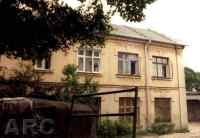 |
| Wirth's House at the Airfield Camp |
In
December 1942, he was given the responsibility of managing and continuing the
construction of the
DAW (Deutsche Ausrüstungswerke / German Equipment Works), slave labour camps in the
Lublin district. Shortly before
Christmas 1942, he moved into a two-storey villa on
Chelmska Street, at the north-west corner of the disused
Lublin airfield. The ground floor rooms were used as offices by
Wirth,
Oberhauser, Hausler and a couple of secretaries. A first class dining
room and living quarters for Wirth were located on the first floor.
Here at the
Airfield Camp, from the
summer of 1942,
three hangars had been used as
the main sorting depot for the heaps of clothing, belongings and valuables taken from the victims of
Aktion Reinhard. This depot was known as "
Bekleidungswerke der Waffen-SS,
Aussenstelle Lublin".
Behind Wirth’s house was a tar-paper factory, and SS-man
Erich Bauer
witnessed how Wirth treated the Jewish workers there:
"
I myself have seen and remember for certain how the Jews employed there were
pouring fresh, hot tar onto the
pasteboard with bare hands. I also saw the raw flesh peeled from their fingers, so that their bare bones could
be seen. I am convinced that all these people died of their bad burns. I remember this work with the tar-paper
so well, because I was upset by it at the time, and Wirth hit me in the face with his whip."
The
"Airfield Camp" was also used throughout
Aktion Reinhard as a mustering
centre for personnel transferred from the euthanasia institutions in the
Reich. They were often met by Wirth,
on occasions accompanied by
Reichleitner from
Sobibor, and
Stangl from
Treblinka. All three
Aktion Reinhard commanders wore the
uniform of officers from the
Schutzpolizei.
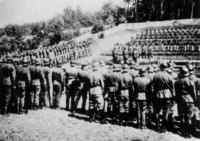 |
| Wirth's Funeral * |
Wirth was
promoted to SS-Sturmbannführer in the
summer of 1943.
Following the revolt in
Treblinka (
2 August 1943),
Globocnik, Stangl, and Wirth
together with other SS men of
Aktion Reinhard, drove in a convoy of lorries to
Trieste. When Wirth reached
Trieste, he set up his headquarters at
Via Martine. A KZ was created at
San Sabba in an old disused rice mill, where a small gas chamber and
incinerator was constructed by
Lambert to kill the Jews of the
Trieste region.
Wirth temporarily returned to
Lublin in
November 1943, where he was involved
in the final destruction of the slave labour camps in the
Lublin district, the so-called
Aktion Erntefest (Harvest Festival).
Sporrenberg, who had taken over from
Globocnik, as
HSSPF Lublin, confirmed under interrogation that
Wirth had been placed in command of this action by
Globocnik, and that it was Wirth
who had read out the order from
Himmler to exterminate all Jews working in the
labour camps of the
Lublin district.
On
26 May 1944* Wirth
was killed in street fighting by Yugoslav partisans.
Franz Stangl stated that he saw Wirth’s body.
Wirth was buried in the German military cemetery at
Costermano.
Photos:
GFH
*
Tregenza Collection
*
Grafeneck Memorial
*
Axis History Forum
*
Sources:
Michael Tregenza:
Belzec Death Camp. Wiener Library
Michael Tregenza:
Zeszuty Majdanka, Lublin 1992&1993
Routledge:
Who’s Who in Nazi Germany
Gitta Sereny:
Into that Darkness
Arad:
Belzec, Sobibor, Treblinka
Personal File of Christian Wirth - BDC
© ARC 2005











